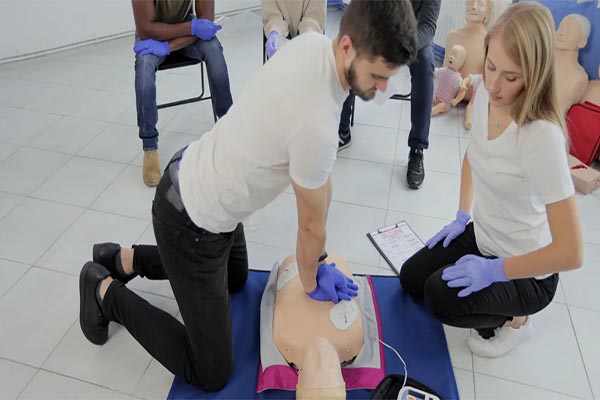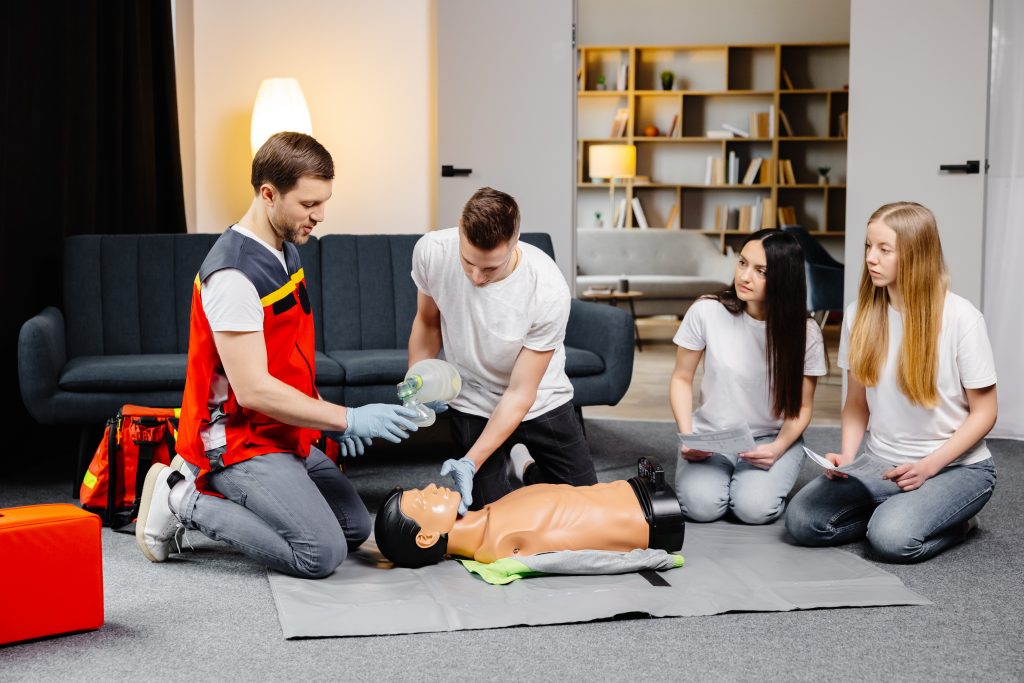
It is perhaps the most common question, and fear, among individuals contemplating CPR certification: “Will I break their ribs?” This hesitation is deeply human. We are hardwired to avoid causing harm, and the thought of inflicting injury upon someone in need is enough to paralyze even the most compassionate bystander.
However, when a person collapses from sudden cardiac arrest, the reality of the situation transforms this fear into an immediate, life-or-death calculation. Cardiopulmonary Resuscitation (CPR) is an inherently forceful procedure. It must be. Its success hinges on overriding the body’s natural resistance to manually pump blood.
In this comprehensive guide, we move beyond the fear. We will explore the factual data surrounding skeletal injury during CPR. Crucially, we will examine the life-saving trade-off and detail how proper, certified technique minimizes risk while ensuring maximum effectiveness. Understanding this balance is not just academic; it is the key to acting decisively when minutes, even seconds, matter.
What Is the Essential Trade-Off When Performing CPR?
The essential trade-off during CPR is stark: The certainty of death versus the possibility of injury.
If an adult has experienced sudden cardiac arrest, their heart has stopped pumping oxygenated blood to the brain and other vital organs. Permanent brain damage can occur in as little as four to six minutes. Without intervention, death is imminent.
The forceful nature of chest compressions is specifically designed to manually circulate this blood until emergency medical services (EMS) arrive. The heart is squeezed between the lower half of the sternum (breastbone) and the spine. This action requires significant pressure.
- Life as the Priority: A broken rib is a treatable injury. Death from cardiac arrest is not reversible.
- The Greater Harm: Hesitating or performing compressions that are too shallow out of fear of causing injury is the guaranteed path to a negative outcome.
- A Necessary Side Effect: Skeletal injury, while never the goal, is often considered a tolerable and necessary side effect of high-quality, life-sustaining CPR.
The American Heart Association (AHA) guidelines emphasize that maintaining continuous circulation is paramount, even if injury occurs. A trained rescuer understands that this risk is a fundamental component of the life-saving equation.

How Often Do Ribs Actually Break During Chest Compressions?
The prevalence of skeletal injury during CPR is much higher than most laypersons realize, yet this fact should never deter action.
Research and medical autopsy data suggest that chest injuries are quite common. These injuries are often not just fractured ribs but also include sternum fractures and costochondral separations (where the cartilage connecting the ribs to the sternum tears).
- Common Statistics: While older estimates suggested around 30% of patients experienced fractures, modern studies reviewed in autopsy data show a much higher incidence.
- Skeletal chest injuries, including rib and sternal fractures, occur in 55% or more of successfully resuscitated cases.
- Some studies focusing on autopsy data of CPR recipients report chest wall injury rates as high as 70% to 90%.
- What is Actually Cracking? The sound many rescuers hear during compressions is frequently the sound of cartilage separating from the bone, known as a costochondral separation, rather than a clean bone fracture. The cartilage is often more brittle than the bone itself, especially under sudden pressure.
- Effective CPR Evidence: In many instances, the occurrence of a fracture or separation can be interpreted as evidence that the rescuer was pushing hard enough to reach the necessary depth. If compressions are too gentle, they are simply ineffective at moving blood, rendering the entire effort moot.
Therefore, the fear should not be if an injury might occur, but rather if your compressions are forceful enough to be effective. High-quality, certified training teaches you to focus on effective blood flow, accepting the possibility of minor injury.
Why Does Effective CPR Require Such Extreme Force?
The force required for high-quality CPR stems directly from human anatomy and the need to mimic the heart’s powerful pumping action.
The adult heart sits between the sternum and the spine. To generate enough pressure to circulate blood, the chest must be compressed deep enough to physically squeeze the heart.
- Required Depth: For an adult, the American Heart Association mandates a compression depth of at least 2 inches (5 cm), but no more than 2.4 inches (6 cm).
- Required Force: Achieving this depth often requires applying anywhere from 60 to over 100 pounds of pressure on the chest wall.
- The Pump Mechanism: When the rescuer pushes down, they are temporarily acting as the heart’s ventricle, pushing blood into the arteries. When the rescuer releases (recoils), the chest springs back, allowing the heart to refill with blood—a crucial step.
- Resistance: The body is designed for structural rigidity and protection. The rib cage is inherently rigid to protect the lungs and heart. Overcoming this natural rigidity requires significant, rhythmic force, which unfortunately stresses the skeletal structure beyond its normal limits.
If the compressions are too shallow, the blood pressure generated will be inadequate to reach the brain, and the victim’s chance of survival plummets. This is why technique prioritizes depth and rate over avoiding a fracture.
Does Proper CPR Technique Minimize the Risk of Skeletal Injuries?
While no technique can eliminate the risk of injury entirely, mastering the proper CPR technique is the single most effective way to minimize unnecessary injury and maximize effectiveness.
The goal of training is not to prevent all injury, but to ensure that any injury that does occur is a consequence of effective, life-saving work, not a mistake in procedure.
- Correct Hand Placement: This is perhaps the most critical factor.
- The heel of one hand should be placed directly on the lower half of the sternum (breastbone), in the center of the chest.
- Hands placed too high, too low, or off-center (too far to the left or right) will transfer the full force directly onto fragile individual ribs, significantly increasing the likelihood of fracture and the risk of internal organ damage.
- Straight Arms and Body Weight: A trained rescuer uses their full body weight, keeping their arms straight and elbows locked, to press straight down. This allows the force to be generated from the hips and shoulders, delivering consistent, controlled pressure perpendicular to the chest. Using only arm strength leads to inefficient, jerky compressions that can cause more harm.
- Full Recoil: Ensuring the chest is allowed to completely recoil after each compression is vital.
- This allows the heart to fully refill with blood.
- It also prevents pressure from being sustained on the skeletal structure, which can cause excessive stress and potentially lead to injury.
By adhering strictly to AHA guidelines taught in certification classes, the rescuer channels the necessary force precisely where it needs to go: onto the sternum, directly above the heart.
What Should a Rescuer Do If They Hear a Crack or Pop During Compressions?
The sensation or sound of a crack or pop beneath the hands during CPR can be shocking and deeply unsettling. However, the response of a certified rescuer is absolute and unwavering: Do not stop compressions.
Hearing a break is not a signal to stop; it is a signal that you are performing with the necessary depth and force.
- Continue Uninterrupted: The victim’s heart is not beating; they are functionally dead until circulation is restored. Stopping CPR will result in a rapid decline in the victim’s chances of survival.
- Check Hand Placement: While continuing compressions, the rescuer should quickly and subtly re-check their hand position. If the hands have shifted off the center of the sternum, they should be adjusted immediately without significantly pausing the rhythm.
- Maintain Depth and Rate: Do not reduce the depth or rate of compressions. Reducing force based on suspected injury makes the remaining compressions ineffective, putting the victim back on the path to death.
- Adjust Positioning, Not Force: If the rescuer is tiring or suspects poor leverage, they can adjust their body mechanics or, if another rescuer is present, switch roles immediately. The key is to maintain high-quality compressions until EMS takes over.
Remember, the Good Samaritan laws in most jurisdictions protect bystanders who act in good faith to save a life, even if injury occurs as a result of the necessary procedure. Your priority must remain the survival of the patient.
Who Is Most Susceptible to Skeletal Injuries During CPR?
While rib fractures can occur in anyone receiving CPR, certain anatomical and physiological factors significantly increase a patient’s susceptibility. Understanding these risk factors helps explain the high incidence rate.
Primary Risk Factors:
- Advanced Age: This is the most dominant factor.
- As people age, bone density naturally decreases, a condition known as osteoporosis.
- Bones become brittle, and the elasticity of the costal cartilage diminishes.
- Patients over 65 years old are significantly more likely to sustain multiple fractures during CPR than younger adults.
- Underlying Bone Conditions:
- Patients with conditions that compromise bone strength, such as severe osteoporosis, specific cancers, or long-term steroid use, are highly vulnerable.
- Gender Differences (Statistical):
- Some large-scale autopsy studies have suggested that women may be statistically more likely to sustain rib and sternal injuries compared to men. This is often attributed to anatomical differences, including generally smaller chest dimensions and lower average bone mineral density compared to age-matched men.
- Improper Technique (The Rescuer Factor):
- While not a patient factor, technique is a massive influence. If a rescuer presses on the lower ribs (floating ribs) or clavicle instead of the sternum, the risk of unnecessary, severe injury skyrockets. Lack of training is a direct injury risk multiplier.
The lesson here is not to treat these patients differently by pushing less hard. The lesson is to recognize that in these high-risk individuals, skeletal injury is virtually unavoidable, reinforcing the principle that saving the life outweighs the complication of injury.
What Are the Post-CPR Consequences of a Broken Rib?
After a successful resuscitation, the victim will require extensive medical care, which will include addressing the inevitable skeletal injuries. While not usually life-threatening, these injuries do require careful management.
The immediate consequences of a broken rib often include:
- Pain and Discomfort: Broken ribs are painful, and the patient will require pain management and observation as they recover.
- Extended Hospital Stay: The presence of rib or sternal fractures will typically prolong the victim’s recovery time in the hospital.
- Potential Complications (Rare but Serious): While rare, severe injuries can include:
- Pneumothorax: A collapsed lung caused by a sharp bone fragment puncturing the pleural membrane.
- Hemothorax: Internal bleeding into the chest cavity.
- Cardiac Injury: Extremely rare, but a shard of bone could potentially lacerate the heart or major blood vessels.
Despite these risks, the vast majority of patients survive CPR with only localized, non-fatal skeletal injury. A physician can repair broken bones; they cannot reverse death. The post-CPR treatment of a rib fracture is routine compared to the catastrophic outcome of brain death due to lack of oxygen. The focus remains on the ultimate positive outcome: Return of Spontaneous Circulation (ROSC) and neurological recovery.

How Does Certification Prepare You for the Unexpected in a Crisis?
The core value of achieving certification with an American Heart Association (AHA) certified training site, like CPR Classes Near Me, is the confidence and muscle memory it provides in the face of chaos.
- Building Muscle Memory: Hands-on training utilizes manikins that provide realistic resistance, helping you gauge the exact force and depth needed for effective compressions. You practice the rhythmic rate and learn to keep your hands correctly positioned without constant visual checking.
- The Psychological Edge: Training demystifies the fear of injury. Instructors explicitly address the “cracking sound” and the reality of fractures. This mental preparation ensures that if you encounter this scenario in real life, you won’t freeze; your training will kick in. You understand that the popping sound is just a mechanical side effect of a life-saving action.
- Understanding the Guidelines: Certification ensures you know the current AHA guidelines (2–2.4 inches, 100–120 compressions per minute). These guidelines are optimized to maximize survival rates while minimizing the risk of improper, unnecessary injury. They represent the scientifically validated “sweet spot” in the trade-off.
Ultimately, certification transforms a hesitant bystander into an assertive rescuer. It replaces panic with a structured, systematic response.
Conclusion: Action Always Outweighs Inaction
The question “Can CPR break ribs?” is answered with a definitive “Yes,” but it must always be followed by the equally definitive truth: You must proceed anyway.
CPR is not a gentle art; it is an aggressive, manual intervention designed to buy time for a person whose life has effectively ended. The potential for a rib fracture is the physical cost of restoring life. It is the life-saving trade-off that every rescuer must be willing to accept. When facing cardiac arrest, the fear of causing a treatable injury must be overwhelmed by the duty to prevent a fatal one.
By obtaining proper certification, you gain the skills to perform CPR effectively, minimize the unnecessary risk of injury, and, most importantly, possess the confidence to act decisively when a loved one or a stranger needs you most.
Be the difference between life and death.
Ready to master these life-saving skills? Don’t let fear prevent you from becoming a rescuer. Contact CPR Classes Near Me today to register for an American Heart Association BLS CPR Certification course. We provide same-day eCards and the highest quality, hands-on training to prepare you for any emergency.
Frequently Asked Questions About Proper CPR Techniques
1. Does a broken rib mean I performed CPR incorrectly?
Not necessarily. A broken rib is often an unavoidable consequence of performing high-quality, effective CPR on an adult, especially an elderly person. It is often cited in medical literature that a fracture is evidence the rescuer applied the required force and depth (2 to 2.4 inches) needed to circulate blood effectively. Improper technique, such as pushing off-center, can cause fractures, but a fracture during correct procedure means you were pushing hard enough to save a life, which is the ultimate priority.
2. Is it better to stop compressions if I hear a cracking sound?
No. If you hear or feel a crack, you must continue compressions without interruption. The priority during cardiac arrest is maintaining circulation and oxygenation to the brain. Stopping CPR because of a suspected fracture immediately eliminates the person’s chance of survival. Quickly check that your hand placement remains centered on the lower half of the sternum, but maintain the prescribed rate of 100–120 compressions per minute and the correct depth.
3. What is the difference between a broken rib and a costochondral separation?
A broken rib (or fracture) is a break in the bone itself. A costochondral separation is a tear or separation of the cartilage that connects the rib bone to the sternum (breastbone). During CPR, the popping or cracking sound is often the cartilage separating rather than the bone fracturing. While both are injuries, cartilage separation is generally less serious than a complete bone fracture, but both require significant force and are managed medically after the victim is stabilized.
4. Are there internal injuries I could cause besides broken ribs?
Serious internal injuries are possible but relatively rare, especially when CPR is performed with proper technique. The most severe, though infrequent, complications include puncturing a lung (pneumothorax), causing internal bleeding (hemothorax), or, in extremely rare cases, lacerating the heart or liver. Proper training minimizes this risk significantly by teaching exact hand placement over the sturdy sternum, thus avoiding the soft tissue of the upper abdomen and the side of the rib cage.
5. Does the use of an AED change the risk of breaking ribs?
No, the use of an Automated External Defibrillator (AED) does not change the risk of breaking ribs. An AED delivers an electrical shock to reset the heart’s rhythm, while chest compressions manually circulate blood. You must continue chest compressions until the AED is ready to deliver a shock and immediately resume compressions after the shock (if necessary). The risk of rib fracture is solely tied to the physical force required for the chest compressions, not the electrical action of the AED.

Leave a Reply